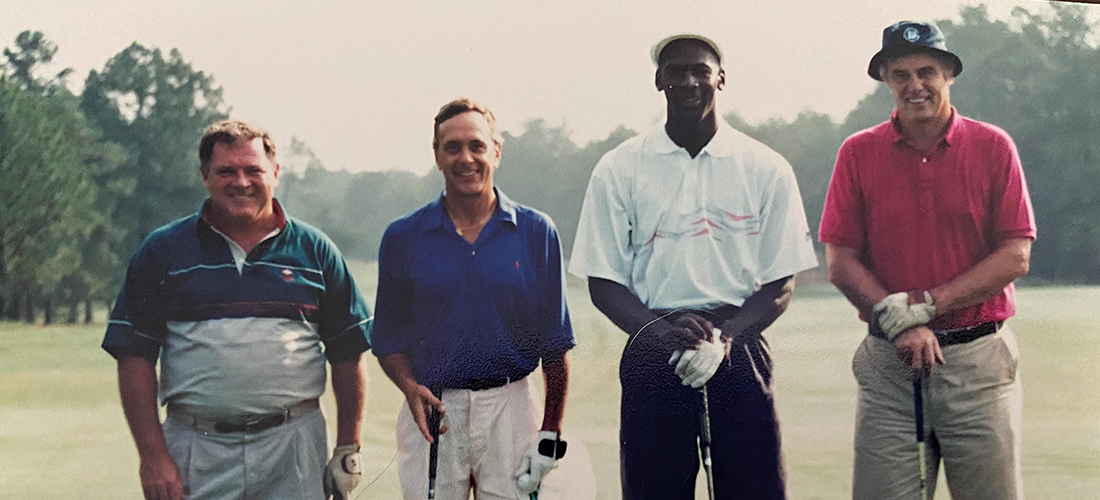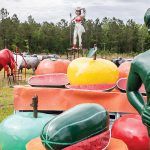
Jordan (Golf) Rules
The Last Dance on the first tee
By Lee Pace
Lew Ferguson opened the golf shop at Pinehurst No. 7 early one morning in June 1990 and exchanged pleasantries with the day’s first golfer to check in. The young man was waiting on the rest of his group to arrive, so he took the chair beside the counter in the golf shop and buried his head in his USA Today.
Another golfer walked in moments later and checked in with Ferguson. The man took note of the guy reading the newspaper, got a quick glimpse of his face and the long legs protruding from the chair. He mouthed in a whisper to Ferguson:
“Is that Michael Jordan?”
The man in the chair overheard the question. He dropped his newspaper to reveal his face.
“Yes,” said Michael Jordan, who then went back to reading his paper without another word. Sadly, what Jordan was reading was an account of his Chicago Bulls team having lost in the NBA Eastern Conference finals to the Detroit Pistons — less than 12 hours earlier.
Ferguson loves telling stories like these. The former head pro at No. 7 and later the director of golf at Pinehurst Resort and Country Club has a bunch of them where Jordan, his love of golf and the Pinehurst golf scene collide.
“The Bulls lost, their season was over, and Michael drove all night long and came straight to No. 7,” Ferguson says. “He rolls into the gate in a black Porche 911 with North Carolina plates and the number 23. I have to say, he was pretty sporty.”
Jordan’s life was dissected to the nth degree recently through the 10-part ESPN documentary The Last Dance. Cursory details of his passion for golf were presented, but the film hardly scratched the surface. With Pinehurst perched within reach of Jordan’s hometown of Wilmington and college headquarters in Chapel Hill, and with his former coach, Dean Smith, himself an avid golfer having many connections in the Sandhills, it’s easy to understand how Jordan found a deep presence in Pinehurst that exists today.
Ferguson made Smith’s acquaintance in the early 1980s when he was working at the Country Club of North Carolina under longtime pro Buck Adams. Smith would visit CCNC often to take lessons from Adams and play the club’s 36 holes. Ferguson had moved to No. 7 when he took a call from Smith one May afternoon in the late 1980s.
“Lew, I need a favor,” Smith said. “Michael needs a place to hide and play golf. Can you help?”
Ferguson secured tee times for Jordan and his entourage, and they would play dawn to dusk, sometimes with Smith joining the competition. Jordan became so enamored with No. 7 that a few years later, he listed it as his favorite course in an American Express commercial. Jordan occasionally ventured over to the main Pinehurst clubhouse for golf on No. 2, particularly when a large group of basketball coaches and players on the NBA and collegiate levels convened in an annual summer outing run by Smith and Doug Moe. Larry Brown, Julius Erving, Bill Raftery, Jerry West, Dave Gavitt and Billy Cunningham were among the regulars in the 1990s.
Brown and Moe were a fixture partnership, and Brown wryly remembers them playing Smith and Jordan at CCNC one year. There was some home construction underway next to one particular tee, and Brown recalls the workers taking respectful note of who was playing.
“When Coach and Michael stepped up to hit, everything got quiet,” Brown says. “You could hear a pin drop. They hit their shots, and then it was our turn. The commotion started right up. Doug and I hit with the hammers and saws going full blast.”
Brown remembers another time he and Jerry West were playing Jordan and Roy Williams, the coach who first recruited Jordan to Carolina in the early 1980s and took over leadership duties of the outing when Smith retired and later quit playing golf.
“Jerry was a really good golfer,” Brown says. “He was probably the best we ever had in our group. Jerry the whole time was trying to pump me up. Oh, man, that was an important match. Boy, was he competitive. All of us were, really. The golf course became a natural extension of the competitive nature that had served us all so well on the basketball court.”
It begs the question, who won the match?
“I remember, but I’ll keep that in the family,” Brown says.
Through the mid-1990s, Jordan visited Peggy Kirk Bell at Pine Needles, Adams at CCNC and Ferguson at Pinehurst until March 1997, when he made the discovery of a new private club on Meyer Farm Drive just northeast of the village. An early Forest Creek Golf Club member named Roy Mashburn was friends with Jordan and invited him to the club with the Tom Fazio-designed course that opened in 1996. Mashburn called Chuck Cordell, the club’s director of marketing and broker-in-charge, and asked him to play with them.
At the time, there few homes built and hardly anyone around. The course was a perfect green, having been over-seeded through the winter, and Fazio’s genius of routing the course through the rolling hills, pine forests and lakes left an indelible mark on Jordan.
“We had not even finished the front nine and Michael’s asking about joining and buying property,” Cordell says. “He said he only owned a house in Chicago and one at Hilton Head that he was fixing to sell. This was a perfect escape for him.”
That was a Wednesday. On Friday, Jordan was back at Forest Creek and looking at a blueprint of lots just opened along the 16th hole of what would be known as the South Course when the second 18, the North Course, opened in 2005. Cordell showed Jordan three lots and said, “One of these would work.”
“I’ll just take all three,” said Jordan.
“I thought he was kidding,” Cordell says. “But he was dead serious. So I said, ‘Well, you want to ride out and I’ll show them to you?’
“He gets that big ol’ smile of his and says, ‘How about we just go play golf and you show them from the golf course?’”
Cordell has seen Jordan break 70 on the Forest Creek South course from the back tees. Over many rounds with Jordan in various locales over more than two decades, he’s learned there are several constants on the golf course: You always play the tips. You always play for money — “whatever makes you nervous,” Jordan likes to say. And you always have to listen to his incessant chatter.
“The only thing that Michael did better than basketball was talking,” says Williams, who after returning to UNC as head coach in 2003, joined Jordan on the Forest Creek membership roster. “You’d better be on his team or he’d talk you to death. He could hit it a long way — sideways every now and then — and he had a nice touch. But you’d better be able to stand up to the lip.”
Jordan did in fact close on buying those lots and still owns the property today, though he’s never built a house on them. When he’s visited Forest Creek over the years — often bringing fellow pro sports and entertainment figures like Mario Lemieux, John Elway, Charles Barkley, Ahmad Rashad and Jack Wagner with him — he’ll stay in one of the club villas or a private home available for a short-term occupancy.
“I’ve always been delighted to see Michael come for a visit, and I’ve been delighted to see him go,” Cordell says with a laugh. “I was a dead puppy after three days. He’s up at 6 a.m. wanting to shoot pool. Then it’s 36 or 54 holes of golf. Then dinner, some wine and poker or more pool — until the wee hours. Then a little sleep and do it all over again.”
Sounds like Michael Jordan is Exhibit A of the golf nuts Pinehurst has been hosting for more than a century. PS
Lee Pace has written about Pinehurst for more than three decades from his home in Chapel Hill. One of his forthcoming projects is a 25-year anniversary of Forest Creek, due out in 2021.





